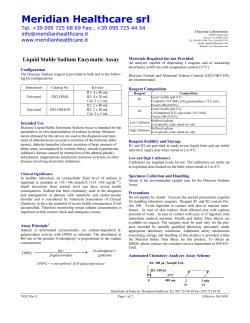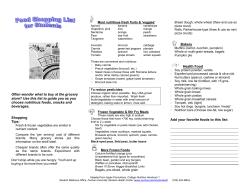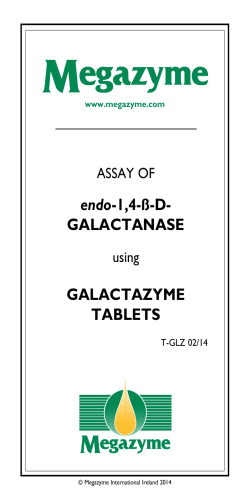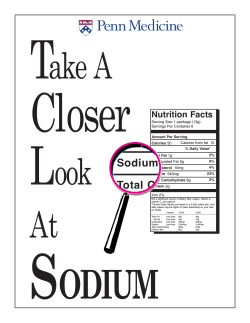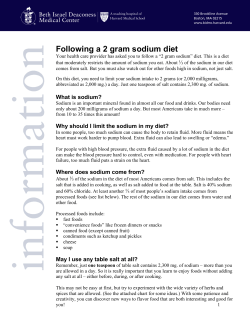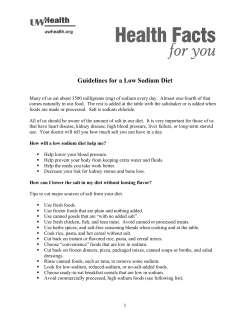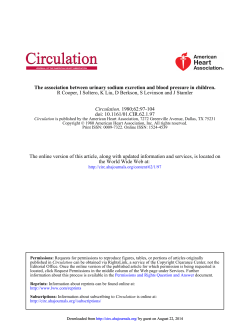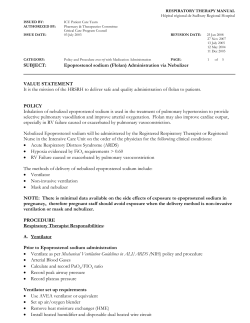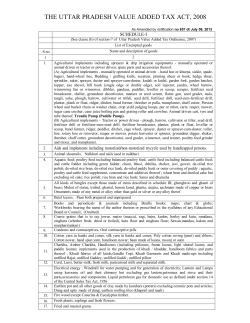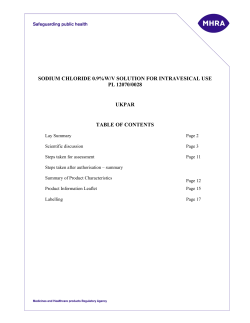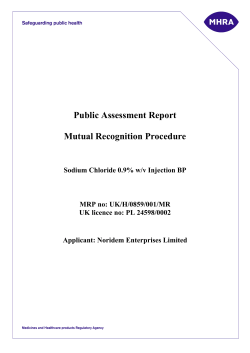
Document 6251
Noninvasive Quantification of Total Sodium Concentrations Myocardial Infarction using 23Na MRI in C. D. Constantinidesl, D. Kraitchman’, K. O’Brien 3, F. Boada4, J. Gillen’, P. A. Bottomley’,” Depts. of Biomedical Engineerin&, Radiology2, and the School of Public Health3, Johns Hopkins University, Baltimore MD, and the Dept. of Radiology, Univ. of Pittsburgh4, PA Introduction: The transport of sodium and potassium between the intra- and extracellular pools and the maintainance of the transmembrane concentration gradients are important to cell function and integrity. The early disruption of the sodium pump in myocardral infarction (MI), in response to the exhaustion of energy reserves following ischemia results in increased intracellular and thus total sodium levels, given that the extracellular sodium pool remains constant. Sodium MRI is uniquely capable of imaging and quantifying endogenous sodium in biological tissue [I]. Recent results suggest 2-fold signal elevations following acute, reperfused MI [2], supporting the view that 23Na MRI may be useful in assessing loss of viability, critical for evaluating patient survival and therapy options following MI. This study quantifies noninvasively total sodium levels in normal and infarcted myocardium in wiwo. Methods: Experiments: Studies were performed on normal (n=6) and infarcted (n=5) mongrel dogs (20-25kg) under anesthesia. Infarction was induced by balloon occlusion of the proximal left anterior descending (LAD) coronary artery for a period of 90-120 minutes, followed by reperfusion. Imaging was performed 3-6 hours post-reperfusion. After MRI, the animals were sacrificed, the heart excised and tissue samples harvested from all regions of the normal hearts and from MI and remote regions in infarcted animals. The samples were rapidly frozen and assayed for total sodium content using atomic absorption spectrophotometry (AAS). In the infarcted animals, the myocardium was incubated in triphenyltetrazolium chloride (TTC) solution, prior to tissue sampling, to distinguish viable from non-viable tissue. Imaging Protocol: MRI was performed on a 1.5T scanner equipped with broadband MRS (General Electric, Milwaukee, WI), using a sodium birdcage coil with a homogeneous B1 field. The imaging parameters for quantitative 23Na MRI were: TR=l2Oms; TE=0.37ms; NEX=14; 1240 projections in 24-32 minutes of total imaging time, using a threedimensional (3D) twisted projection 23Na imaging (TPI) sequence [3]. Relaaation Measurements: Fast (Tzf) and slow (Tz8) transverse relaxation measurements were performed in normal (n=3) and infarcted (n=3) heart regions using the TPI sequence with TE=0.37-20ms; TR=55ms; 1240 projections; NEX=4; and 4 minutes of total imaging time per scan. Measured 23Na signal intensities were fitted to bi-exponential relaxation curves using a nonlinear mean-least-squares fitting procedure based on the Marquardt-Levenberg algorithm. Quantification: The sodium concentration was determined in heart wall regions of the 23Na MRI images as the ratio of the mean 23Na signal (SN~) in a selected region of interest, to the sodium signal from an external saline reference standard ) of 1OOmM in concentration: (SNa,ref [N&ssue= pwnl,ef Na,ref (1) MRI relaxation effects were omitted since imaging was performed under fully relaxed conditions (TR>3Tl,TE<<Tzf). Phantom Experiments: To assess the susceptibility of the TPI sequence to periodic motion, as reflected in concentration estimates from 23Na images, aqueous NaCl solutions (50-150mM) Proc. Intl. Sot. Mag. Reson. Med. 8 (2000) 130 were imaged using a cyclically moving phantom [l], under controlled conditions, with speed settings of 40-60rpm and linear displacements of 12-17mm to emulate heart motion, emp Figure 1: Sodium images from a lOOmM NaCl phantom at (Right) Tabu(Left) rest and (Mid) during periodic motion. lated sodium concentration results from moving phantoms. Results: Figure 1 shows 23Na images of a 1OOmM NaCl phantom at rest and during periodic motion. All [Na] estimates from images of the moving phantoms were not significantly different (p < 0.001) from the actual phantom concentrations (Fig. 1, Table 1). Figure 2 depicts typical axial sodium images of a normal (a) and an infarcted (b) heart. Sodium T2f and Tzs values in normal hearts (n=3) were found to be 2.44&0.4ms and 15.22&1.8ms, respectively, and 2.04f0.2ms and 22.72f3.4ms in infarcted hearts (n=3). Mean sodium estimates from normal myocardium using AAS yielded a value of 32.87k6.5 mmol/kg wet wt., in agreement with the tabulated MRI results (Fig. 2, Table 2). Estimated sodium concentrations in infarcted hearts from the 23Na MRI were significantly higher (p < 0.001) from normal levels and ranged from 50-90mmol/kg wet wt., depending on the time of imagin ” Basal Mid Aoical deanrtSD ~ -, -. 33.81* 2.9 34.23* 3.2 36.28+2.6 33.98* 3.3 32.50* 3.2 34.6Okl.8 33.29* 2.3 34.06rt 2.8 32.40+ 2.2 33.92* 34.04* 34.65t2.2 3.3 2.3 Figure 2: (Top) Axial 23Na images from normal (a) and infarcted (b) hearts, and (Bot) tabulated [Na] estimates from the 23Na images of normal hearts. Conclusion: Fast 3D TPI sequences with ultrashort TE values allow accurate quantification of total sodium in wivo. The quantification method allows serial, non-destructive, noninvasive, absolute [Na] measurements in normal and infarcted hearts. We envisage that such a technique can become a clinical tool for monitoring total sodium content during the oral evolution of infarction in viva. K3Lences: 1. Constantinides C,. et al., Proc. IS ‘MRM, p.211, 1999. 2. Kim RJ, et al., Cb-culation LX.1877. -, -_. I lW7. --3. Boada FE, et.al., Magn. Reson. Med. 37,706-715,1997. 4. Moore C, et al., Radiology 190, 765-9, 1994. Acknowledgments: We thank Drs. R. Balaban and E. their advice and Mrs. Sanju Jalla and Dong technical assistance. This work was partially by the grant ROl HL61695.
© Copyright 2025


